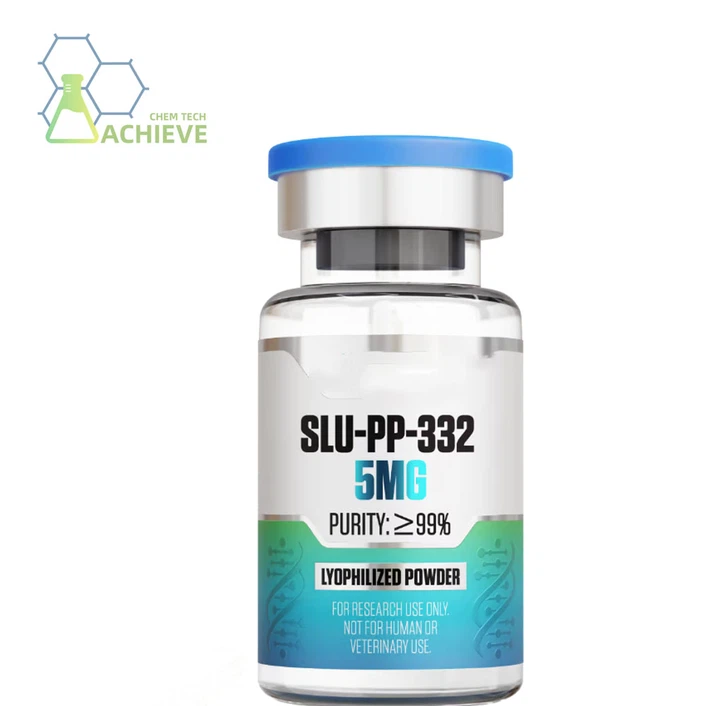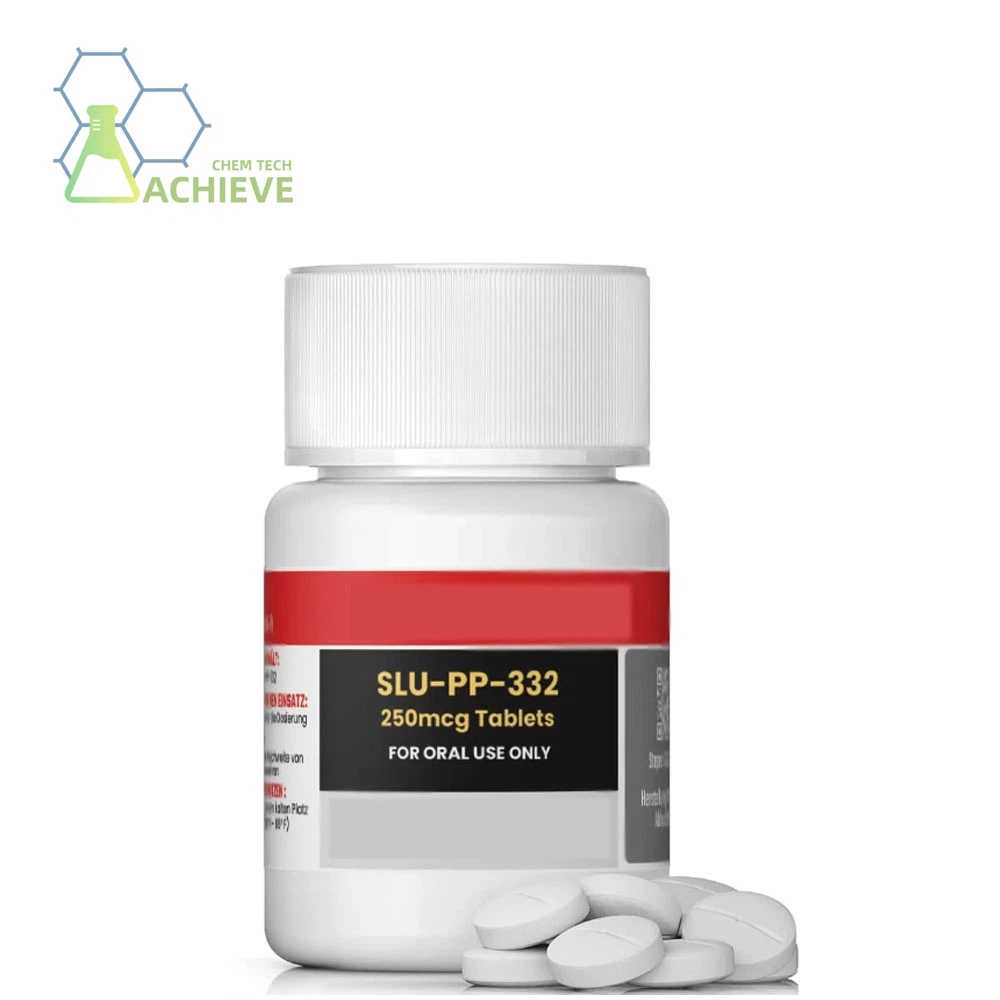Slu-PP-332 Peptide is a small molecule compound with the molecular formula C18H14N2O2 and a molecular weight of 290.32. Its structure consists of naphthalene ring, benzene ring, and hydrazide groups, and this unique molecular configuration endows it with the ability to bind estrogen related receptors (ERRs) with high affinity. As a pan ERR agonist, Slu-PP-332 has EC ₅₀ values of 98 nM, 230 nM, and 430 nM for ERR α, ERR β, and ERR γ, respectively, with the strongest activation effect on ERR α. This characteristic makes it an ideal tool molecule for studying the function and metabolic regulation of ERRs.
At the same time, our company not only provides SLU-PP-332 pure powder, but also offers tablets, injections, and capsules. If needed, please feel free to contact us at any time.

Treatment with Slu-PP-332 (0-5 μ M, 24 hours) significantly increased the protein expression of mitochondrial respiratory chain complex I (NDUFB8) and complex V (ATP5A), while inducing upregulation of mitochondrial biogenic marker genes PGC-1 α and TFAM. After activating ERR γ, the expression of fatty acid oxidation related genes CPT1A and ACADL increases, and lipid accumulation decreases. After 28 days of continuous intraperitoneal injection of Slu-PP-332 (50 mg/kg, twice daily) into obese mice, body weight decreased by 12% -15%, fat mass decreased by 22%, and no hepatotoxicity or nephrotoxicity was observed; After administration to mice with heart failure, myocardial cell crest density increased by 40%, fatty acid oxidase activity increased by 2.1 times, and exercise endurance significantly improved; Meanwhile, in 24 month old mice, Slu-PP-332 can reverse muscle atrophy, increase muscle fiber cross-sectional area by 15% -20%, and delay age-related metabolic decline.
| Price List of Slupp-332, CAS 303760-60-3 | |||||||
| Category | Specification (Content/PCS) |
Qty | Unit Price (EXW,USD$/Unit) |
Total Price (EXW,USD$) |
Package | Unit | Remark |
| Capsule | 250mcg | 500 1,000 10,000 |
$0.50/PCS $0.32/PCS $0.10/PCS |
$250 $320 $1,000 |
Aluminum foil bag
or negotiable |
PCS | Reamrk: 1.The less quantity, the more loss of customization, so we designed 2 to 4 times formula, in order to confirm the content is enough. 3.Tablet if you need, your qty should be more than 5k. 4.Plastic bag and aluminum foil bag is easy to clear your customs. 5.Printing Customization(Boxes & bottles' body), negotiatable. |
| 500mcg | 500 1,000 10,000 |
$0.60/PCS $0.39/PCS $0.11/PCS |
$300 $390 $1,100 |
PCS | |||
| 1mg | 500 1,000 10,000 |
$0.72/PCS $0.47/PCS $0.13/PCS |
$360 $470 $1,300 |
PCS | |||
| 5mg | 500 1,000 10,000 |
$0.92/PCS $0.58/PCS $0.20/PCS |
$460 $580 $2,000 |
PCS | |||
| 10mg | 500 1,000 10,000 |
$1.12/PCS $0.70/PCS $0.24/PCS |
$560 $700 $2,400 |
PCS | |||
| 20mg | 500 1,000 10,000 |
$1.36/PCS $0.92/PCS $0.38/PCS |
$680 $920 $3,800 |
PCS | |||
| Injection | 5mg/vial | 1 | $195/Box | $195 | 10 vials/Box | Box | MOQ 1 Box |
| API (Pure powder) |
HPLC>99.0% HNMR |
10 100 1000 |
$30.0/Gram $12.0/Gram $6.8/Gram |
$300 $1,200 $6,800 |
(1)Internal: PE bag+Al foil bag (2)External: Paper box |
Gram | MOQ 10 grams |
Our product




SLU-PP-332 COA

Classification and specific manifestations of adverse reactions
Slu-PP-332 Peptide, as a novel peptide, was initially discovered to have potential roles in regulating physiological functions and participating in specific pathological processes of diseases. Therefore, it attracted the attention of researchers and began to enter the laboratory research and some early clinical trials. However, as research progresses, the potential adverse reactions it may cause gradually become apparent. These adverse reactions not only affect the clinical application prospects of the peptide substance, but also directly impact drug safety. Therefore, a systematic and comprehensive study and analysis of its adverse reactions has important theoretical significance and practical application value.
Local adverse reactions
Local adverse reactions are a type of reaction that is more likely to occur during the administration of Slu-PP-332 drug, mainly concentrated in the administration site and surrounding tissues. They are usually related to the stimulation of local tissues by the drug, improper administration methods, or individual differences in local sensitivity to the drug.
In experimental studies and early clinical observations using Slu-PP-332 for injection administration, redness, swelling, and pain at the injection site were the most common local adverse reactions. Research data shows that approximately 30% -40% of individuals in experimental animals (such as mice and rats) and a small number of volunteers who receive injections of this peptide exhibit varying degrees of redness and swelling at the injection site. The range of redness and swelling is usually small, with a diameter of 1-3 centimeters and a color of light red or pink. It usually appears within a few hours after administration, and some individuals' redness and swelling symptoms can disappear on their own within 1-2 days. However, there are also a few individuals whose redness and swelling lasts for a long time, up to 3-5 days. Pain symptoms often accompany redness and swelling, and the degree of pain varies from person to person. Some individuals may only experience mild pain or swelling, which does not affect normal activities; However, a small number of sensitive individuals may experience more obvious pain, and even the pain intensifies when touching or moving the surrounding tissues of the injection site, causing certain interference in daily life. Further research has found that this redness, swelling, and pain response may be due to the stimulation of local capillaries at the injection site by Slu-PP-332 drug, leading to capillary dilation and congestion, as well as the release of local inflammatory mediators (such as histamine, prostaglandins, etc.), thereby causing local tissue inflammation.

Local skin itching and rash

In addition to redness, swelling, and pain, local skin itching and rash are also possible local adverse reactions that Slu-PP-332 may cause. In related studies, about 15% -20% of experimental subjects experienced skin itching symptoms after administration, with itching mainly concentrated around the injection site. Some individuals may scratch due to itching, leading to skin damage and increasing the risk of infection. The manifestations of rash are diverse, commonly including papules, urticaria, etc. Spotted papules are mostly scattered red small papules with a diameter of about 1-2 millimeters, and some papules may merge into patches; Urticaria presents as a wheal like rash, with a light red or pale white color, varying in size and irregular shape. It usually appears within a few hours and can self resolve within a few hours to days, but is prone to recurrence. After analysis, this type of skin reaction may be a manifestation of allergic reactions. Slu-PP-332 Peptide, as an exogenous substance, may be recognized by the immune system as a "foreign body" after entering the body, triggering an immune response and releasing allergic mediators, leading to symptoms such as skin itching and rash.
In rare cases, Slu-PP-332 drug may cause severe local adverse reactions such as local tissue hardening and necrosis. In current research cases, only a few experimental animals have experienced such situations. Local tissue induration is usually manifested as a hard mass with unclear boundaries at the injection site, which may be accompanied by pain when pressed. The resolution time of induration is relatively long, and some may take several weeks or even months. However, local tissue necrosis is even rarer. Once it occurs, it can lead to ischemia and hypoxia in the injection site tissue, resulting in necrosis. This is manifested as blackening of the local skin color, tissue ulceration, pus discharge, etc., which seriously affects the local tissue function. Moreover, the treatment is difficult and often requires debridement, and may even leave scars. The mechanism of this serious local adverse reaction may be due to the high concentration of the drug in the local tissue, which has a toxic effect on tissue cells, destroys cell structure and function, leads to cell death, and subsequently causes tissue hardening and necrosis; It may also be related to an individual's extreme sensitivity to drugs, leading to strong local inflammatory reactions and tissue damage.

Systemic adverse reactions
Compared to local adverse reactions, systemic adverse reactions have a wider range of impacts and may involve multiple systems and organs in the body, affecting the overall health status of the body. Some serious systemic adverse reactions may even endanger life, so they need to be highly valued.
The digestive system is one of the commonly affected systems when Slu-PP-332 Peptide causes systemic adverse reactions, mainly manifested as nausea, vomiting, diarrhea, abdominal pain, and other symptoms. In relevant clinical and animal experiments, about 25% -30% of the subjects showed varying degrees of digestive system symptoms. Nausea symptoms usually appear within a few hours after administration, manifested as discomfort and nausea in the upper abdomen. Some individuals may experience vomiting, which is mostly stomach contents. The frequency of vomiting varies, ranging from 1-2 times to several times. The incidence of diarrhea symptoms is relatively low, with nausea and vomiting accounting for about 15% -20%. It is characterized by an increase in the frequency of bowel movements, changes in stool characteristics, and mostly watery or pasty stools. Some individuals may also experience abdominal pain, which is mostly located around the navel or lower abdomen. The nature of the pain is often paroxysmal colic or dull pain, and the severity of the pain varies. Severe cases may lead to complications such as severe abdominal pain, frequent diarrhea, dehydration, and electrolyte imbalance.

Neurological adverse reactions

Neurological adverse reactions are also one of the systemic adverse reactions that Slu-PP-332 Peptide may cause. Although the incidence is relatively low, the impact on the body cannot be ignored, mainly manifested as symptoms such as headache, dizziness, fatigue, and drowsiness. In rare cases, psychological symptoms such as insomnia, anxiety, and restlessness may occur. The incidence of headache symptoms in the experimental subjects is about 10% -15%. The headache site is mostly bilateral temples or forehead, and the nature of the pain is mostly swelling pain, dull pain or pulsating pain. The severity of the pain varies. Some individuals' headache symptoms may be relieved after rest, while a few individuals' headaches may last for a long time, affecting normal work and life. The incidence of dizziness symptoms is similar to that of headaches, about 10% -12%, manifested as head heaviness, visual rotation or unstable standing, especially when changing positions (such as standing up from a sitting or lying position), the symptoms may be more obvious, and severe cases may cause falls due to dizziness, resulting in accidental injury.
Hot Tags: slu-pp-332 peptide, suppliers, manufacturers, factory, wholesale, buy, price, bulk, for sale, Cosmetic, DERMORPHIN, dermorphin in humans, dermorphin peptide, Melanotan ii powder










